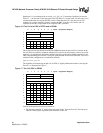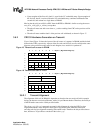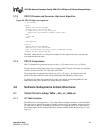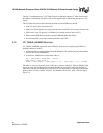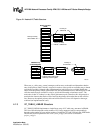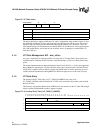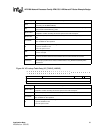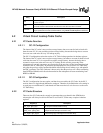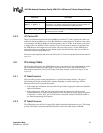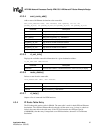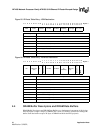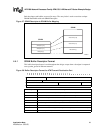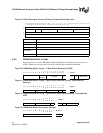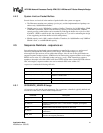
IXP1200 Network Processor Family ATM OC-3/12/Ethernet IP Router Example Design
34 Application Note
Modified on: 3/20/02,
4.2 Virtual Circuit Lookup Table Cache
4.2.1 VC Cache Function
4.2.1.1 OC-12 Configuration
The intent of the VC cache is not to reduce average latency but to account for back to back cells
from the same VC. It is not possible to reduce average latency because the design has to account
for worst case cache miss on every VC lookup anyway.
The OC-12 configuration caches the results of VC Table lookup operations in absolute registers.
The intent of the VC cache is not to reduce average latency, but rather to account for back-to-back
cells from the same VC. It is not possible to reduce average latency, because the design has to
account for worst-case cache miss on every VC lookup. In this scenario, processing of the
subsequent cell can only commence once processing of the previous cell has been completed and
recorded in the VC Table Entry. In particular, the subsequent cell can access the VC Table Entry
only after the previous cell has updated the buffer offset telling the cell where to go, and updated
the CRC syndrome. The CRC syndrome is known only after the previous cell is done transferring
from RFIFO to DRAM, and it must be known before the subsequent cell starts transferring from
RFIFO to DRAM.
4.2.1.2 OC-3 Configuration
The OC-3 configuration does not require, and thus does not enable, the VC Cache. In the OC-3
receiver, there is a single thread dedicated to each port. Therefore, by definition the cells coming in
on each port are on different VCs and threads will thus never have to wait for access to the same
VC Table Entry.
4.2.2 VC Cache Structure
There are four VC Cache entries, enough to guarantee that every thread in the ATM Receive
microengine will always be able to find one to use. Each VC Cache entry occupies 6 absolute
registers.
AAL
5: ATM Adaptation Layer 5
0: VC is not open
CRC
The CRC-32 syndrome associated with the PDU. It is saved in the VC table entry after a cell
is moved, and then retrieved and used when the next cell in the PDU is received.
Cell Data11
The last four bytes of the previous cell in this PDU. Used during re-assembly of PDUs to allow
8-byte quadword burst writes to DRAM without using DRAM Read/Modify/Write instructions.
Entry Description
Register(s) Description
@vc_key0...@vc_key3 VC and port associated with the entry
@seq_enter0...@seq_enter3
@seq_exit0... @seq_exit3
Implement a sequence number for each entry to maintain the order that
multiple threads attempt to access the entry.
@vc_flags0...@vc_flags3 Local working copy of the flags in the VC Table Entry.



